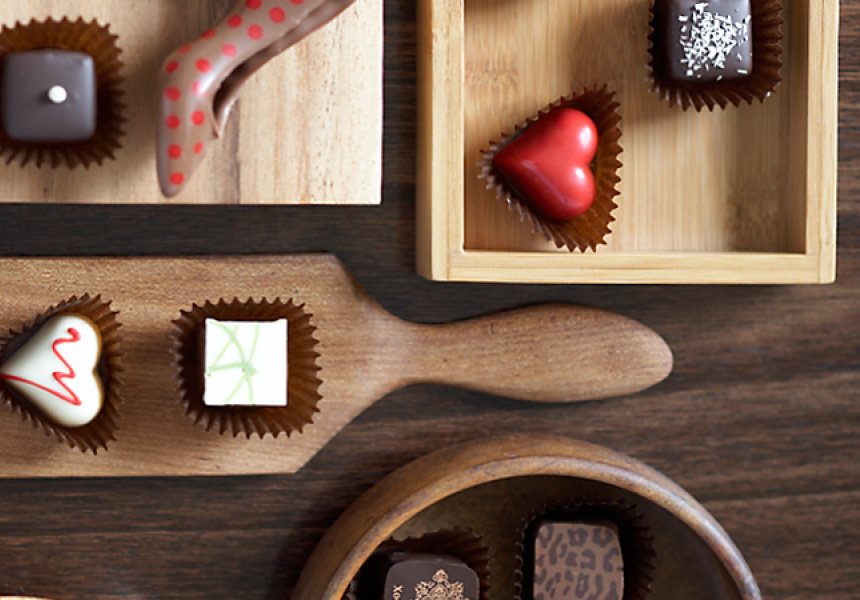Try as many chocolates as you can.
It’s the most inspiring advice I’ve ever received when it comes to finding the best chocolate – and considering it’s coming from Christos Partsioglou, I’m taking it to heart.
“Try many different chocolates from many different places. It’s the only way to come to the conclusion [about] which ones suit your palate best,” says the artisan chocolatier, obviously not afraid of a little healthy competition.
“We recommend our customers to try other chocolatiers and we’re pretty comfortable about it, because we know they come back,” he says with a big smile as we nestle at a table in his specialty chocolate shop, Xocolatl, in Kew.
We think you might like Access. For $12 a month, join our membership program to stay in the know.
SIGN UPInspired by a rose-infused hot chocolate, we’re decoding the art of finding the best chocolate on offer in a market swamped with the stuff, and what makes it such a great comfort food as the cooler months set in.
“The reason it’s the perfect comfort food is that first, it has an incredibly rich and complex flavour; and second, it actually melts in the mouth and fills the palate. It uses all your senses,” says the self-professed Oompa Loompa with a contented smile.
“We infuse the favours inside the actual hot chocolate, rather than just melting chocolate with milk. It’s more difficult for us to make, but it’s part of being artisan – putting in the extra effort and love to see the satisfaction on people’s faces.”
For Partsioglou finding the perfect chocolate is about creating a layering of flavours with a balance that you can’t find anywhere else. And after establishing a solid following for traditional flavours, it was a simple next step to creating his own.
“We started with basil and champagne. Everyone thought I was crazy to bring it in,” he says, laughing. “They said ‘you can’t have savoury in chocolate’.” Thank god he didn’t listen, because it became a regular favourite.
Partsioglou now counts gorgonzola and mango, balsamic strawberry, and lavender amongst his many carefully crafted creations. And despite being playfully reticent when it comes to sharing his flavour secrets, there were a few tips he was willing to pass on: “First look for the best possible product. We only use Belgian couverture chocolate and we also carry Valrhona [a gold-standard French chocolate, considered some of the best in the world]. That’s basic. But then, with the fruit flavours, wherever possible we only use fresh fruit. For the orange ganache we zest our own oranges and we use fresh juice. The same with lime and ginger.”
From there, he says it’s all about looking for the perfect combination, organising layers and finishing the details to create the ideal balance so that one flavour does not outweigh or overpower the others.
Apparently it also helps to be a little bit mad and obsessive about chocolate in order to get it just right. And Thibault Fregoni, artisan chocolatier at Fitzroy’s Monsieur Truffe agrees.
“I got a bit hooked really,” he says, explaining that he was working as a pastry chef when he discovered chocolate. But his lack of formal training makes Fregoni’s attitude to chocolate more pliable that most. Where Partsioglou seeks to expand the palate by complementing and pushing it with new and unusual flavour combinations, Fregoni works on a process of stripping back in order to appreciate the chocolate alone.
“Really what we are doing here is stepping away from Belgian style, the bon-bon and praline. We’re moving away from filling the chocolate and lots of decoration. The idea is to really focus on the chocolate as a raw ingredient,” he says in a rich French accent.
The conversation quickly turns to the new interest in single-origin chocolate. “With known-origin chocolate it doesn’t mean that it’s better, it means that what talks is the cocoa – according to where it’s grown, the type of tree, how it’s been handled. There is nothing to work against it, there’s just the natural flavour of the cocoa,” he says with conviction, pointing out that, as with specialty coffee, it’s the variations in chocolate rather than the uniformity that makes it interesting.
For Fregoni, identifying the best chocolate involves helping consumers to see the product in a new light. “It’s a way of relaying to people what chocolate is, which is the seed of a fruit. When chocolate is decorated or wrapped there’s not much connection with the fruit and the seed. It’s interesting to be able to create the link. Because like wine or like coffee, it’s affected by the type of soil, the tree and the weather. Working with single estate, you expect it to be different every year. To have its own personality. It’s another way of appreciating it.” Similar to a vintage of wine.
When pressed for his best tip, there’s a long pause while he thinks. “What you should aim for is a chocolate that leaves you satisfied when you eat just a little bit, because of the intensity of flavour. It should linger. I think that’s what’s lacking in mass-produced product. It doesn’t mean it’s bad, but it is always the same.”
So depending on what suits your style, it’s good to know that there’s something on offer for everyone. But the question remains, what’s the best way to identify it? Try as many chocolates as you can; it’s all in the name of research.
Taste Test
Xocolatl: (for handmade treats and fanciful flavours)
www.xocolatl.com.au
123 Maling Road, Canterbury
(03) 9836 3100
11 Strathalbyn Street, Kew East
(03) 9857 0971
Monsieur Truffe: (for single origin)
90 Smith Street, Collingwood
(03) 9416 3101
Also soon to open on Lygon Street; watch this space.
Shocolate: (For hot chocolate)
www.shocolate.com.au
3/296 Brunswick Street, Fitzroy
(03) 9415 6556
Haighs: (for traditional flavours)
www.haighschocolates.com.au

